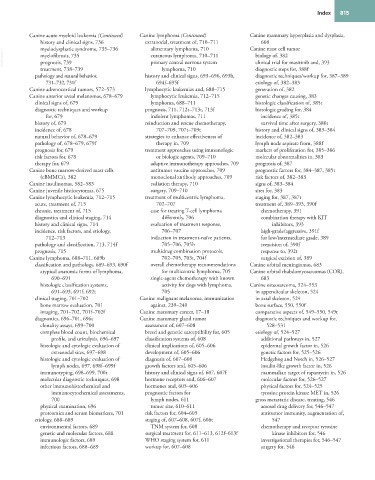Page 837 - Withrow and MacEwen's Small Animal Clinical Oncology, 6th Edition
P. 837
Index 815
Canine acute myeloid leukemia (Continued) Canine lymphoma (Continued) Canine mammary hyperplasia and dysplasia,
history and clinical signs, 736 extranodal, treatment of, 710–711 Canine mast cell tumor
608
alimentary lymphoma, 710
myelodysplastic syndrome, 735–736
VetBooks.ir myelofibrosis, 735 cutaneous lymphoma, 710–711 biology of, 382
prognosis, 739
clinical trial for masitinib and, 393
primary central nervous system
treatment, 738–739 lymphoma, 710 diagnostic steps for, 388f
pathology and natural behavior, history and clinical signs, 693–696, 693b, diagnostic techniques/workup for, 387–389
731–732, 731f 694f–695f etiology of, 382–383
Canine adrenocortical tumors, 572–573 lymphocytic leukemias and, 688–715 generation of, 382
Canine anterior uveal melanomas, 678–679 lymphocytic leukemia, 712–715 genetic changes causing, 383
clinical signs of, 679 lymphoma, 688–711 histologic classification of, 385t
diagnostic techniques and workup prognosis, 711, 712t–713t, 713f histologic grading for, 384
for, 679 indolent lymphomas, 711 incidence of, 385t
history of, 679 reinduction and rescue chemotherapy, survival time after surgery, 386t
incidence of, 678 707–709, 707t–709t history and clinical signs of, 383–384
natural behavior of, 678–679 strategies to enhance effectiveness of incidence of, 382–383
pathology of, 678–679, 679f therapy in, 709 lymph node aspirate from, 388f
prognosis for, 679 treatment approaches using immunologic markers of proliferation for, 385–386
risk factors for, 678 or biologic agents, 709–710 molecular abnormalities in, 383
therapy for, 679 adaptive immunotherapy approaches, 709 prognosis of, 387
Canine bone marrow-derived mast cells antitumor vaccine approaches, 709 prognostic factors for, 384–387, 385t
(cBMMCs), 382 monoclonal antibody approaches, 709 risk factors of, 382–383
Canine insulinomas, 582–583 radiation therapy, 710 signs of, 383–384
Canine juvenile histiocytomas, 675 surgery, 709–710 sites for, 383
Canine lymphocytic leukemia, 712–715 treatment of multicentric lymphoma, staging for, 387, 387t
acute, treatment of, 715 702–707 treatment of, 389–393, 390f
chronic, treatment of, 715 case for treating T-cell lymphoma chemotherapy, 391
diagnostics and clinical staging, 714 differently, 706 combination therapy with KIT
history and clinical signs, 714 evaluation of treatment response, inhibitors, 393
incidence, risk factors, and etiology, 706–707 high-grade/aggressive, 391f
712–713 induction in treatment-naïve patients, for low/intermediate grade, 389
pathology and classification, 713, 714f 705–706, 705b reexcision of, 390f
prognosis, 715 multidrug combination protocols, response to, 392t
Canine lymphoma, 688–711, 689b 702–705, 703t, 704f surgical excision of, 389
classification and pathology, 689–693, 690f overall chemotherapy recommendations Canine orbital meningiomas, 683
atypical anatomic forms of lymphoma, for multicentric lymphoma, 705 Canine orbital rhabdomyosarcomas (COR),
690–691 single-agent chemotherapy with known 683
histologic classification systems, activity for dogs with lymphoma, Canine osteosarcoma, 524–553
691–693, 691f, 692t 705 in appendicular skeleton, 524
clinical staging, 701–702 Canine malignant melanoma, immunization in axial skeleton, 524
bone marrow evaluation, 701 against, 239–240 bone surface, 550, 550f
imaging, 701–702, 701f–702f Canine mammary cancer, 17–18 comparative aspects of, 549–550, 549t
diagnostics, 696–701, 696t Canine mammary gland tumor diagnostic techniques and workup for,
clonality assays, 699–700 assessment of, 607–608 528–531
complete blood count, biochemical breed and genetic susceptibility for, 605 etiology of, 524–527
profile, and urinalysis, 696–697 classification systems of, 608 additional pathways in, 527
histologic and cytologic evaluation of clinical implications of, 605–606 epidermal growth factor in, 526
extranodal sites, 697–698 development of, 605–606 genetic factors for, 525–526
histologic and cytologic evaluation of diagnosis of, 607–608 Hedgehog and Notch in, 526–527
lymph nodes, 697, 698f–699f growth factors and, 605–606 insulin-like growth factor in, 526
immunotyping, 698–699, 700t history and clinical signs of, 607, 607f mammalian target of rapamycin in, 526
molecular diagnostic techniques, 698 hormone receptors and, 606–607 molecular factors for, 526–527
other immunohistochemical and hormones and, 605–606 physical factors for, 524–525
immunocytochemical assessments, prognostic factors for tyrosine protein kinase MET in, 526
700 lymph nodes, 611 gross metastatic disease, treating, 546
physical examination, 696 tumor size, 610–611 aerosol drug delivery for, 546–547
proteomics and serum biomarkers, 701 risk factors for, 604–605 antitumor immunity, augmentation of,
etiology, 688–689 staging of, 607–608, 607f, 608t 547
environmental factors, 689 TNM system for, 608 chemotherapy and receptor tyrosine
genetic and molecular factors, 688 surgical treatment for, 611–613, 612f–613f kinase inhibitors for, 546
immunologic factors, 689 WHO staging system for, 611 investigational therapies for, 546–547
infectious factors, 688–689 workup for, 607–608 surgery for, 546

